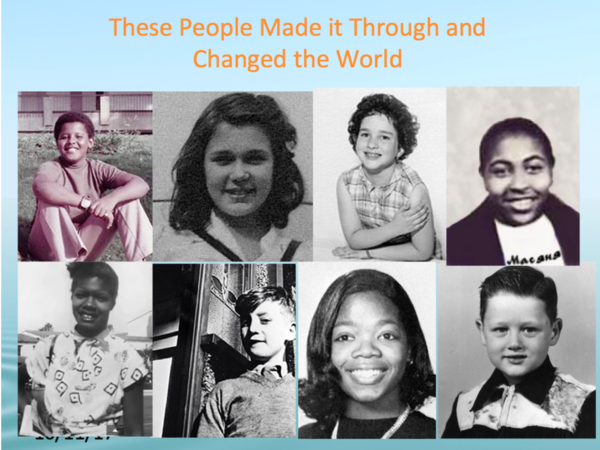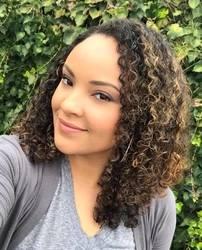photo courtesy of EOYDC
In a room in East Oakland, Calif., photos of children are projected on a screen. “Who is that?” asks Briana Moore, a licensed clinical social worker in private practice and a master trainer for the East Bay Agency for Children’s Trauma Transformed program. “Bill Clinton,” responds one of the 20 employees of the East Oakland Youth Development Center (EOYDC). Moore asks the same question about the others pictured in the slide: Tina Turner, Sonya Sotomayor, Gloria Steinem, John Lennon, Barack Obama, Maya Angelou and Oprah Winfrey.
 It’s the beginning of a training session about trauma and resilience. The goal is to educate everyone from maintenance and janitorial services personnel to direct services workers and a vice president of the organization. It’s part of the organization’s plans in a year-long project with other Oakland-based community groups. They want to build on the strengths of the organization to help youth succeed academically in school and in their careers as adults, says Selena Wilson, the organization’s vice president of organizational effectiveness.
It’s the beginning of a training session about trauma and resilience. The goal is to educate everyone from maintenance and janitorial services personnel to direct services workers and a vice president of the organization. It’s part of the organization’s plans in a year-long project with other Oakland-based community groups. They want to build on the strengths of the organization to help youth succeed academically in school and in their careers as adults, says Selena Wilson, the organization’s vice president of organizational effectiveness.

“We have been working on being a trauma-informed organization and wanted to move to the next level of becoming a healing organization,” says Wilson. “As part of that, we wanted to include not only the key staff, but also the art instructors, the security guards, the facility team members… anyone who comes in contact with the young people and parents we serve.”
EOYDC offers an array of classes, from homework club, cooking, dance and art to computer skills training, leadership and visits to college campuses. It serves 2,000 youth annually; 95 percent of young people in its Pathways to College program graduate high school on time. Seventy-one percent of EOYDC students who began college in 2012 finished it within 5 years, and 90 percent of those who passed their G.E.D. found a job, started vocational training or registered at community college within six months, according to data provided by Wilson.
A video posted on the organization’s website describes some of the ways that trauma and toxic stress can touch the lives of the youth EOYDC serves: Half of Oakland’s homicides occur in their neighborhood and 25 percent of the residents in the area live in poverty.
All of the participants in the trauma training are looking at the childhood images of the larger-than-life figures. Besides sharing a place in history for their achievements, the well-known figures are linked in another way. They all had experienced substantial adversity as children, explains Moore. “So, all of these people had very, very high ACE scores,” Moore says referring to the landmark CDC-Kaiser Permanente Adverse Childhood Experiences Study (ACE Study), which tied 10 types of adverse childhood experiences (ACEs) to adult onset of chronic disease, mental illness, violence or being a victim of violence. The ACEs include experiencing physical, sexual or emotional abuse; living with a family member who abuses alcohol, or drugs or is mentally ill; experiencing divorce, and having a family member who is incarcerated.
The study of 17,000 mostly white, college-educated Kaiser patients, all with jobs and great health care, explains Moore, showed that 65 percent had experienced at least one ACE. Subsequent ACE studies, Moore told participants, have included groups of color and expanded the types of ACEs. Examples of additional types of ACEs include questions about being bullied, experiencing community violence, racism, living in a war zone, having a family member deported and being involved in the foster care, immigration or criminal justice systems.
Moore tells how Obama spent his early years in Kansas with a white mother and an African father at a time when blended families weren’t accepted, and then his father moved back to Kenya. Maya Angelou had been raped by an uncle as a child. Winfrey was raised by her grandmother in the South at a time when children were to be seen and not heard, and was beaten or whipped for asking questions or speaking up, explains Moore.

How did they survive? They all are resilient, explains Moore. “My ACE score is 7, says Moore. “But my resilience score means that I’m still standing, in spite of all the difficulties I’ve gone through” she says. “From being molested to being treated poorly by white people who were my managers, and all of those situations that caused me hurt, harm and danger. My mother being an alcoholic, having mental health issues in my family. I’m a recovering addict with 33 years clean. So, you know I’ve had trauma in my life,” says Moore, describing some of her own ACEs.
“But what’s important is I'm still standing.”
“And each and every one of you who have experienced episodes of trauma,” she continues, “What’s important to remember about this is, they’re still standing as well,” pointing to the childhood images of Obama, Winfrey and the others.
Moore’s co-presenter, Darryen Green, another trainer for Trauma Transformed, explains how over time when someone has experienced constant, unpredictable toxic stress, it changes the biology of the brain so that toxic stress can a person into “fight, flight or freeze” mode where their response — fighting, running away or not responding — may be interpreted as “oppositional behavior.” However, this behavior is simply a reflection of how the nervous system has adapted to triggers.
Moore drives home the point by reframing behavior that may be triggered by trauma: “Sometimes those people with complicated vulnerabilities, they live in the threat mode, and they don’t know how to come out of the threat mode, So this is a situation where you use compassion and see life through their eyes,” she suggests, alluding to a video shown earlier that walks viewers through an exercise that explores empathy and looks past the image a person projects to the feelings that lurk beneath the surface.

Days after the training, Landon Hill, EOYDC’s senior manager of program effectiveness, says he had already seen an example of how staff digested that part of the training. ”We had an issue with a young lady. It came out that there was some stuff going on at home that may have influenced her actions,” explains Hill. “One of the staff members said, ‘I hope we’re not going to kick her out. Because this was the stuff we just talked about in the training.’ That he linked it directly back to the trauma-informed training we did was great!”

During the 3.5-hour training, Moore and Green demonstrated a number of tools that staff members could use to calm themselves down or diffuse a tense situation, including breathing techniques. “It’s a cause for a pause. Take a deep breath and ask yourself, ‘What’s happening here? What’s going on with this person?’ Breathing and shifting your perspective actually shifts your brain into higher gear,” explains Green. “That exercise allows you to respond to the underlying issues, rather than what the behavior is.”
The trainers also moved from practical tools to look at larger forces that produce trauma and trauma-inducing systems. And for that, the issue of racism was front and center. Moore talks about her fears about her grandson’s safety knowing soon he will get a driver’s license. “And he’s got these gold teeth in his mouth, dreadlocks, and when he’s not around me, he wears his pants down below his butt,” she says smiling as she furrowed her brow. “And all I could see was the police stopping him, and I said to him – her voice rose -- ‘What do you do with your hands?!’ He says to me, ‘I keep my hands on the steering wheel, I don’t touch my phone. I don’t look away from him and I do keep eye contact.’”
“I was so worried about him — what he’d do if he faced this kind of micro-aggression, because sometimes young people don’t know when to keep quiet. Other groups don’t really have to train their children about what to do if they get stopped by the police, but we do,” she says.
Moore talked about other ways that racism makes its mark: “We know that institutional racism happens in organizations that are snowcapped, that people don’t have people of color in the leadership.” The exclusion of diverse people in an organization, including in leadership roles, she says, leads to what’s called “affinity bias” where people who are too similar in background generally come up with similar ideas – not a diversity of views that enhance growth.
Racism was one of the ACEs included in the Philadelphia ACE Study. According to the study:
“Philadelphia's demographic makeup looks significantly different than the original study, in which the majority of participants were white, college-educated, and middle-income. In Philadelphia, where roughly a quarter of residents live in poverty, researchers found that almost seven in ten adults had experienced one ACE and two in five had experienced four or more.
“The community-level indicators included witnessing violence, living in foster care, bullying, experiencing racism or discrimination, and feeling unsafe in your neighborhood. Researchers found that almost 40 percent of Philadelphians had experienced four or more of these expanded, community-level ACEs.”
Racist forces in overt and unconscious bias take their toll on health, explains Moore, who says her father died at the age of 58 in 1964 from a massive heart attack. “He was a Pullman Porter, a taxi driver and a door man at the Continental Hotel,” recalls Moore, recounting how her father was well loved in the community where she grew up in San Francisco’s Potrero Hill Neighborhood Public Housing. She acknowledges that her father had an unhealthy diet, but that wasn’t all. “My daddy had a lot of holes in his soul. He was a Pullman Porter on the train where he had to say ‘Yes, sir’ and ‘No, sir’.” Then he was a taxi cab driver ‘Yes, sir’ and ‘No, sir’. And he was a doorman, ‘Yes, sir’ and ‘No, sir’. And many times, people didn’t see him. He was a big man, but because he was a black man, many times people didn’t see him.”
“Our elders are invisible, but they’re still standing,” she continues. Moore talks about a trip to Ghana that she took where she witnessed the cages where 400 years ago black people were chained and enslaved. During the visit, the trip leader told the group: “They said we’d never come back, and we’re back stronger than we ever were before!’”
“That’s the kind of resilience we have in our community,” adds Moore, “dealing with all these inequities and isms.”
Selena Wilson, EOYDC’s vice president of organizational effectiveness, says that on the same day of the training, another part of the group’s Breakthrough Series Collaborative project was also launching. The organization is collaborating with the Oakland-based Youth Uprising to destigmatize mental health services for its teens.
Of the trauma training, she explains, the practical tools provided to de-escalate tense situations when people are triggered is one key takeaway. Another is how it addresses issues that impact their community: “This is actually the first time that I’ve really been privy to a discussion of how racial equity and bias intersects with trauma-informed systems. For an organization that serves pretty much all students of color, it was really helpful to understand how all those things intersect in this framework. Because we understand at an experiential level that’s the case, just being a person of color in a society built on white supremacy exacerbates trauma. But those deep discussions were really helpful.”






Comments (0)